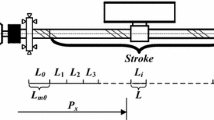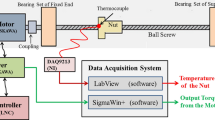Abstract
In a feed drive system, friction is a typical nonlinear component that increases the complexity of the dynamic behavior. A feed drive system equipped with rolling contact components, such as ball screws and linear motion guides, undergoes complicated friction behavior. In this regard, various techniques have been proposed to decrease the effect of friction and thus achieve the precise control of the feed drive system. Friction compensation control is a widely used technique that cancels out the friction force by applying an additional driving force that corresponds to the friction estimated by a friction model. A variety of friction models have been proposed to estimate the friction force accurately for friction compensation control. However, conventional friction models have focused on estimating the friction force of a feed drive system operating in atmospheric pressure although air pressure affects the friction characteristics. The accuracy of the conventional friction models might decrease for a feed drive system operated in a vacuum. This paper presents a friction compensation controller on the basis of a new friction model that considers the effect of the vacuum pressure on friction. A vacuum chamber that can control the vacuum pressure and a vacuum-compatible feed drive system are constructed to measure the friction force at various vacuum pressures. The relationship between the friction characteristics and the vacuum pressure is investigated on the basis of the experimental results and applied to the friction model. A friction compensation controller based on the friction model and Kalman filter is designed and evaluated experimentally.
Similar content being viewed by others
References
Y. Altintas, A. Verl, C. Brecher, L. Uriarte and G. Pritschow, Machine tool feed drives, CIRP Ann-Manuf. Technol., 60 (2) (2011) 779–796.
W. Lee, C.-Y. Lee, Y. H. Jeong and B.-K. Min, Distributed component friction model for precision control of a feed drive system, IEEE/ASME Trans. Mechatronics, 20 (4) (2015) 1966–1974.
B. Armstrong-Helouvry, P. Dupont and C. C. D. Wit, A survey of models, analysis tools and compensation methods for the control of machines with friction, Automatica, 30 (7) (1994) 1083–1138.
C. Aguilar-Avelar, R. Rodríguez-Calderón, S. Puga-Guzmán and J. Moreno-Valenzuela, Effects of nonlinear friction compensation in the inertia wheel pendulum, Journal of Mechanical Science and Technology, 31 (9) (2017) 4425–4433.
M. Tomizuka, Zero phase error tracking algorithm for digital control, J. Dyn. Syst. Meas. Control-Trans. ASME, 109 (1) (1987) 65–68.
C.J. Kempf and S. Kobayashi, Disturbance observer and feedforward design for a high-speed direct-drive positioning table, IEEE Trans. Control Syst. Technol., 7 (5) (1999) 513–526.
C.-J. Lin, H.-T. Yau and Y.-C. Tian, Identification and compensation of nonlinear friction characteristics and precision control for a linear motor stage, IEEE/ASME Trans. Mechatronics, 18 (4) (2013) 1385–1396.
M. Iwasaki, T. Shibata and N. Matsui, Disturbance-observer-based nonlinear friction compensation in table drive system, IEEE/ASME Trans. Mechatronics, 4 (1) (1999) 3–8.
J.-S. Chen, K.-C. Chen, Z.-C. Lai and Y.-K. Huang, Friction characterization and compensation of a linear-motor rolling-guide stage, Int. J. Mach. Tools Manuf., 43 (2003) 905–915.
T. H. Lee, K. K. Tan and S. Huang, Adaptive friction compensation with a dynamical friction model, IEEE/ ASME Trans. Mechatronics, 16 (1) (2011) 133–140.
J. Yao, W. Deng and W. Sun, Precision motion control for electro-hydraulic servo systems with noise alleviation: A desired compensation adaptive approach, IEEE/ASME Trans. Mechatronics, 22 (4) (2017) 1859–1868.
C. C. D. Wit, H. Olsson, K. J. Astrom and P. Lischinsky, A new model for control of systems with friction, IEEE Trans. Autom. Control, 40 (3) (1995) 419–425.
F. Al-Bender, V. Lampaert and J. Swevers, The generalized Maxwell-slip model: A novel model for friction simulation and compensation, IEEE Trans. Autom. Control, 50 (11) (2005) 1883–1887.
W. Lee, C.-Y. Lee, Y. H. Jeong and B.-K. Min, Friction compensation controller for load varying machine tool feed drive, Int. J. Mach. Tools Manuf., 96 (2015) 47–54.
E. A. Deulin, V. P. Mikhailov, Y. V. Panfilov and R. A. Nevshupa, Mechanics and Physics of Precise Vacuum Mechanisms, Springer (2010) 45–79.
J. Jellison, R. Predmore and C. L. Staugaitis, Sliding Friction of Copper Alloys in Vacuum, NASA Goddard Space Flight Center (1968).
D. H. Buckley, Friction, Wear and Lubrication in Vacuum, NASA Lewis Research Center (1971).
W. Lee, C.-Y. Lee and B.-K. Min, Simulation-based energy usage profiling of machine tool at the component level, Int. J. Precis. Eng. Manuf.- Green Tech., 1 (3) (2014) 183–189.
Acknowledgments
This work was supported by the Basic Science Research Program through the National Research Foundation of Korea (NRF) funded by the Ministry of Science, ICT & Future Planning (NRF-2019R1F1A1050719).
Author information
Authors and Affiliations
Corresponding author
Additional information
Recommended by Editor Hyung Wook Park
Wontaek Song is a graduate student at the School of Mechanical Engineering, Yonsei University. His present research interests include modeling and precision control of feed drive systems.
Jaeyoon Shim is a graduate student at the School of Mechanical Engineering, Gwangju Institute of Science and Technology. His present research interests include robotic auto-lapping systems.
Namhyun Kim is a graduate student at the School of Mechanical Engineering, Chungnam National University. His present research interests include precision control of robot arms and feed drive simulation.
Geun Byeong Chae is a graduate student at the School of Mechnical Engineering, Chungnam National University. His present research interests include monitoring and control of machining processes based on machinine learning.
Wonkyun Lee received his B.S. and Ph.D. degrees in Mechanical Engineering in 2008 and 2015, respectively, from Yonsei University, Seoul, South Korea. He is currently an Assistant Professor at the School of Mechanical Engineering, Chungnam National University, since 2016. His research interests include robotic machining systems, machine learning, friction compensation control, and machine tool optimization based on cyber-physical systems.
Rights and permissions
About this article
Cite this article
Song, W., Shim, J., Kim, N. et al. Friction compensation control of a feed drive system operated in a vacuum. J Mech Sci Technol 33, 5353–5360 (2019). https://doi.org/10.1007/s12206-019-1028-0
Received:
Revised:
Accepted:
Published:
Issue Date:
DOI: https://doi.org/10.1007/s12206-019-1028-0




